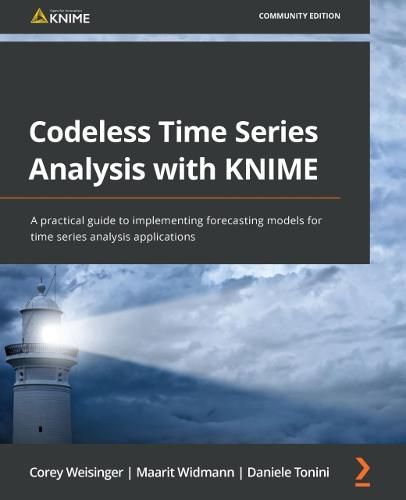Readings Newsletter
Become a Readings Member to make your shopping experience even easier.
Sign in or sign up for free!
You’re not far away from qualifying for FREE standard shipping within Australia
You’ve qualified for FREE standard shipping within Australia
The cart is loading…






This title is printed to order. This book may have been self-published. If so, we cannot guarantee the quality of the content. In the main most books will have gone through the editing process however some may not. We therefore suggest that you be aware of this before ordering this book. If in doubt check either the author or publisher’s details as we are unable to accept any returns unless they are faulty. Please contact us if you have any questions.
Perform time series analysis using KNIME Analytics Platform, covering both statistical methods and machine learning-based methods
Key Features
Gain a solid understanding of time series analysis and its applications using KNIME Learn how to apply popular statistical and machine learning time series analysis techniques Integrate other tools such as Spark, H2O, and Keras with KNIME within the same application
Book DescriptionThis book will take you on a practical journey, teaching you how to implement solutions for many use cases involving time series analysis techniques.
This learning journey is organized in a crescendo of difficulty, starting from the easiest yet effective techniques applied to weather forecasting, then introducing ARIMA and its variations, moving on to machine learning for audio signal classification, training deep learning architectures to predict glucose levels and electrical energy demand, and ending with an approach to anomaly detection in IoT. There’s no time series analysis book without a solution for stock price predictions and you’ll find this use case at the end of the book, together with a few more demand prediction use cases that rely on the integration of KNIME Analytics Platform and other external tools.
By the end of this time series book, you’ll have learned about popular time series analysis techniques and algorithms, KNIME Analytics Platform, its time series extension, and how to apply both to common use cases.
What you will learn
Install and configure KNIME time series integration Implement common preprocessing techniques before analyzing data Visualize and display time series data in the form of plots and graphs Separate time series data into trends, seasonality, and residuals Train and deploy FFNN and LSTM to perform predictive analysis Use multivariate analysis by enabling GPU training for neural networks Train and deploy an ML-based forecasting model using Spark and H2O
Who this book is forThis book is for data analysts and data scientists who want to develop forecasting applications on time series data. While no coding skills are required thanks to the codeless implementation of the examples, basic knowledge of KNIME Analytics Platform is assumed. The first part of the book targets beginners in time series analysis, and the subsequent parts of the book challenge both beginners as well as advanced users by introducing real-world time series applications.
$9.00 standard shipping within Australia
FREE standard shipping within Australia for orders over $100.00
Express & International shipping calculated at checkout
This title is printed to order. This book may have been self-published. If so, we cannot guarantee the quality of the content. In the main most books will have gone through the editing process however some may not. We therefore suggest that you be aware of this before ordering this book. If in doubt check either the author or publisher’s details as we are unable to accept any returns unless they are faulty. Please contact us if you have any questions.
Perform time series analysis using KNIME Analytics Platform, covering both statistical methods and machine learning-based methods
Key Features
Gain a solid understanding of time series analysis and its applications using KNIME Learn how to apply popular statistical and machine learning time series analysis techniques Integrate other tools such as Spark, H2O, and Keras with KNIME within the same application
Book DescriptionThis book will take you on a practical journey, teaching you how to implement solutions for many use cases involving time series analysis techniques.
This learning journey is organized in a crescendo of difficulty, starting from the easiest yet effective techniques applied to weather forecasting, then introducing ARIMA and its variations, moving on to machine learning for audio signal classification, training deep learning architectures to predict glucose levels and electrical energy demand, and ending with an approach to anomaly detection in IoT. There’s no time series analysis book without a solution for stock price predictions and you’ll find this use case at the end of the book, together with a few more demand prediction use cases that rely on the integration of KNIME Analytics Platform and other external tools.
By the end of this time series book, you’ll have learned about popular time series analysis techniques and algorithms, KNIME Analytics Platform, its time series extension, and how to apply both to common use cases.
What you will learn
Install and configure KNIME time series integration Implement common preprocessing techniques before analyzing data Visualize and display time series data in the form of plots and graphs Separate time series data into trends, seasonality, and residuals Train and deploy FFNN and LSTM to perform predictive analysis Use multivariate analysis by enabling GPU training for neural networks Train and deploy an ML-based forecasting model using Spark and H2O
Who this book is forThis book is for data analysts and data scientists who want to develop forecasting applications on time series data. While no coding skills are required thanks to the codeless implementation of the examples, basic knowledge of KNIME Analytics Platform is assumed. The first part of the book targets beginners in time series analysis, and the subsequent parts of the book challenge both beginners as well as advanced users by introducing real-world time series applications.